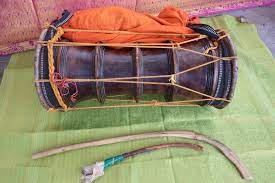Urumi
இந்தப் பக்கத்தை தமிழில் வாசிக்க: உறுமி
This musical instrument is called Urumi because it sounds like an animal roaring . It is a two-sided leathered instrument . It is played by tapping a long curved stick on one end of the instrument and a straight stick on the other end . The tune raised out of knocking both the sides of the instrument is considered unique . The legacy message is that the Urumi will be made with the skin of a buffalo killed by a tiger on a full moon day. The instrument is played in the performing arts such as 'Naiyandi Melam', 'Devarattam', 'Kalaikkuttu', 'Urumi Komali Attam', 'Kattaik Kuzhal', 'Mayilattam', 'Puliyattam' and 'Kavadiyattam'. It is also known as 'Devathunthupi'.
Design
Urumi is a two-sided musical instrument. It is slightly larger , shaped like Udukkai , which is a member of the family of membranophone percussion instruments of India . It is made of bull skin . It is said to be made of the skin of a bull hunted by a tiger on the full moon day. It is played by tapping a long curved stick on one end of the instrument and a straight stick on the other end . When both the sides of the instrument are tapped using the sticks , a distinctive sound is produced .
Performing Method
The instrument is played by tying both ends of the instrument with a strap or cloth and tying it across the shoulders and tapping it with the sticks .
Components of the instrument
This musical instrument is made of buffalo or goat skin.
The body frame is made of wood and the outer part is made with seven or eight holes and is fastened with rope.
Performing groups
The instrument is played by Arundhatiyar caste artists, a section of the Kambala Nayaks, in satirical melody. Urumi is the only instrument played in Devarattam . But the Devarattam artists do not want to call it Urumi. They call it Devathunthupi. The Sillavar caste people have an ancient story for this nomenclature.
Ancient Storyline
The wedding ceremony of Lord Shiva and Parvati took place at Kayilai hill. At the wedding ceremony, theological women danced and the celestial gods played their respective musical instruments. Nandi Devar played Mridangam. The gods were all mesmerized by his music. It made Nandi arrogant. He thought that the theological women could dance only because he played the mridangam. Lord Shiva wanted to remove the arrogance of Nandi .
Shiva magically enlarged the shape of his musical instrument, Udukkai, and asked Nandi to play it. He couldn't perform it. Shiva asked Narada to play it. He too couldn’t do it.
Shiva came to the world. There, he gave it to the priest who was worshiping him with the erukkam flower and asked him to play it. The priest asked how to play it. Shiva asked him to pick two sticks from the ground and play the instrument using it . The priest took a bent stick and rubbed it on one side. Tapped the other side with a small stick. The noise arose. The priest used both the sticks on the instrument simultaneously . The tune from one face of the instrument made the sound Om. The tune from the other side of the instrument sounded 'Sakthi'. The music of Om Sakthi filled the air in Kayilai hill . The gods were all mesmerized by the music. The theological women danced spontaneously for the music . Nandi Devar’s arrogance was contained. Lord Shiva disappeared, saying to the priest, "Let it be played on earth. Give it to my people who are born on earth as 'Nayakargal'."
It is called 'Devathunthupi' because it is music heard by the gods. The Sillavar caste people believe it to be a divine musical instrument. Arundhatiyar is playing Urumi in Devarattam at present. Arundhatiyar considers it as their ethnic identity. A.K. Perumal, a field researcher, notes that the Sillavar caste people play this instrument in some places.
References
- Thamilaga Nattar Nigalthu Kalaigal - A.K. Perumal
- https://web.archive.org/web/20070818170239/http://learningobjects.wesleyan.edu/vim/cgi-bin/instrument.cgi?id=74
Links
⨮ Standardised-en
Please do not write any content below this line. This section is only for editing templates & categories.

